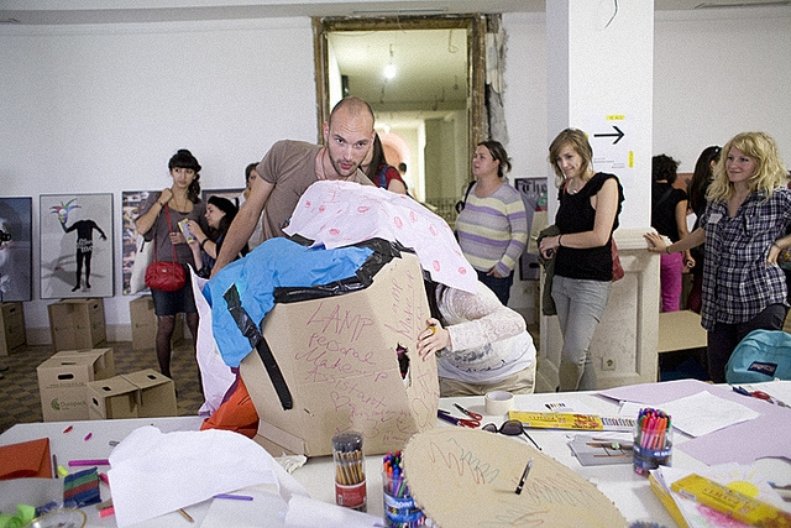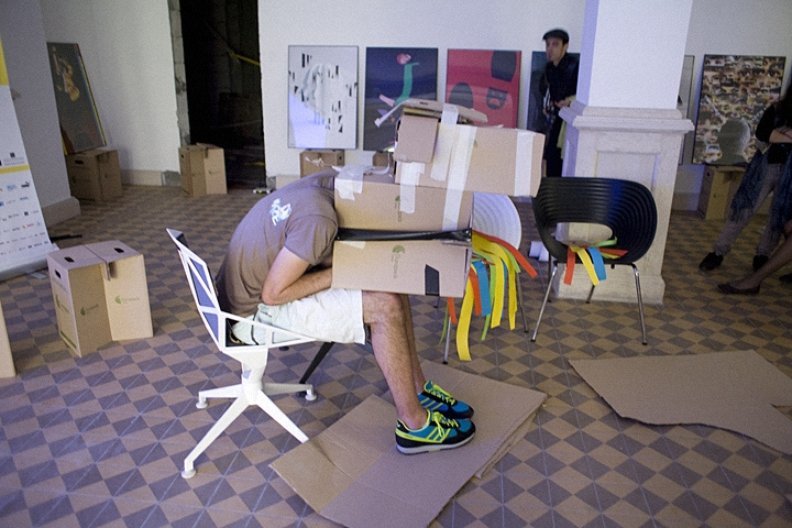24 June 2011
by Nelly Ben Hayoun
Nelly Ben Hayoun travelled to Sofia to contribute to the Design Week, which ran from 10-18 June 2011 and was supported by the British Council.
With the title “Design is all around” the Sofia Design week kicked off on June 10th. With a very broad international range of creative minds discussing their various practices, from graphic designer to curators to interior and furniture designers including well known Matali Crasset ,Konstantin Grcic and one of our host Valentin Vodev, Sofia Design week was a real patchwork of today’s design.
This mix of practitioners sharing moussaka and stuffed cabbage every evening at the same table was a very ingenious way to generate new collaborations and inventive sparklers in everyone’s mind!
For me, it all started at the airport. This is where I met with Michael Marriott, designer. He missed his plane the day before, which, in a way, was ‘fortunate’ as it allowed us to travel together in a taxi from Sofia airport to the ‘Hotel Expo’ where we were staying.
This short journey with our Bulgarian correspondent Krassimira Tantcheva was very informative. Krassi shared with us her views on the history of the city of Sofia as well as on his cultural and architectural development.
In her opinion the remaining buildings from the soviet time should disappear, “they are overcrowded and not responding to the new needs of their inhabitants”.
While for Michael Marriot, it was important to keep them for their simple modernism and the fact that they were purely there to deliver their function. While the debate was growing in our little car, it appeared that in fact History was more the problem, Sofia’s citizens were trying to move on from the soviet times and they needed to build a new horizon for themselves.
Heritage luxury
This debate reminded me a talk by OMA creator and co-founder of Volume, Rem Koolhaas, I heard the week before during the Festarch International Architecture Festival in Perugia, Italy.
In a talk mentioning the Heritage luxury, the Dutch architect, shared his view on respecting the past, instead of turning it into something beautiful.
He said we are “obsess[ed] by the preservation of space, we want to maintain the tradition, what we end up doing is destroying history by our intent to preserve it”.
In 1790, after the French Revolution, the Commission des monuments was created. This comprised guidelines to preserve a part, or the whole, of existing buildings. By being classified “Historique Monument E”, a building was marked with a set of rules to avoid modifications.
In 1987 the Unesco World Heritage Convention declared that 12% of the world will never be modified. “How ironic is this situation? In a context where all changes radically everyday, every time, some part of the world will remain forever the same,” said Koolhaas.
This listed cultural heritage also contains story telling, festivals, and processions.
“This heritage is increasing with tourism, Heritage used to be seen as being against development but now heritage is development. The past is becoming our future.”
Koolhaas pointed out situations in which this becomes problematic, namely authenticity and restoration. “The Patrimoine Mondial preserves artificially. We will not preserve council houses from the 60s, or places of disaster such as the Chernobyl site, or the twin towers. We will rather prefer turning them into something beautiful and aesthetically interesting.”
This thinking contributed to the other concept presented by Koolhaas, the thinning of a city.
While travelling through the periphery of Sofia with Michael and Krassi, I couldn’t stop and remember the words by Rem Koolhaas….
Was Sofia victim of this thinning? By making new and destroying the old buildings from the soviet time, what will remain for the future generations to remember how it was?
But Krassi could argue that this is more complex than that, Sofia is in transition, but most of the new building are in fact still under construction, or frozen in time waiting to be achieved. The new isn’t there yet in Sofia, so the heritage remains… at least for now.
The Everyday Estrangement:
I was in Sofia to deliver a talk on my practice and a workshop called Domestic Super Objects.
Domestic Super Objects was inspired by the Nonsence Method developed by Japanese designer Maywa Denki and it was investigating how to use the everyday as the main source for creativity.
This is how Michel de Certeau introduces his work on of the everyday creativity:
“The purpose of this book is to explicit the systems of operational combination
[les combinatoires d’operations] which also compose a “culture”, and to highlight the models of actions characteristic of users”.
It is fascinating to consider that the everyday is made of “systems of operational combination”, those “systems” that can be source of creativity and sometimes innovation. Indeed, the nonsense method of Nobumichi Tosa or Brecht’s theory of estrangement are two systems which can generate creativity within the everyday as well as being responsible for the development of amateur culture.
So what is the Nobumichi Tosa’s nonsense method? First of all, you have the
common sense; a pillow for example and the image in your mind of a pillow are conformed to the reality. The all process of nonsense resides in the estrangement. By adding the word “strange” in front of all objects and by wondering what is the image of a “strange pillow”, for example, you modify the usual representation of your environment.
According to Nobumichi Tosa, “Nonsense is everywhere”, the humanity evolution is “nonsense”.
As observed Brecht: “Things become part of the everyday by becoming invisible, unnoticed, part of the furniture. And if familiarity does not always bring contempt, it does encourage neglect.”
To ‘make’ the everyday creative you need to go inside the “invisible”, you need to enter in a world of defamiliarization, where everything become strange and take a new aspect. Once things become unfamiliar, you can develop some new way of experimenting with it.
Far from all academic methods, it’s more a “hands-on” philosophy, which is here required.
I believe that the “theory of estrangement” developed by Bertolt Brecht for an experimental theater is source of creation.
When audiences face the unfamiliar, the strange, the haphazard and the impromptu, this can develop some very innovative, fresh way of shaping. As explained Ben Highmore about Brecht methods: “by insisting on the “Eskimo definition” that ‘a car is a wingless aircraft that crowls along the ground”, the car is momentarily rescued from the naturalized attention by being made strange (denaturalized).”
But this is not only a question of representation; this method can also lead to design.
Participants to the workshop had to consider their everyday and its properties, as well as answering a simple question, “what they wish it could be?”
This provided them with the scene in which they developed their designs.
One project was about a rice cooker which could use the steam from the bath to get power, an other was looking on how a couch could turn into a beer brewer device while one of the participant was swimming into a suitcase.
All participants had to then draw and plan how they will be making their work and finally they had to perform their work, and to come up with solution on how to mime the steam or how to turn weights into lights.
The result they provided was unique and certainly based on fact but with the final result being close to fantasy. By creating this in-between space, our participants generated a new niche for their objects.
Krassi and myself awarded 3 winners with the title “Sofia Design Week designer of the future 2011”.

